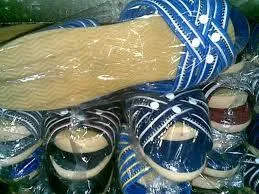Alfombra

There are 488 registered industries based on the report of the Business Permit and Licensing Office. However, based on the breakdown given by the LGU there were only about 227 establishments in 1998. Garment factories constitute almost 40% of the total industrial establishments, which exist on all barangays of the municipality. Most of these garment factories are located in Barangay San Roque, Sta. Ana, Sto. Rosario-Silangan and Aguho. The slipper manufacturing called alfombra slippers comprise 27% -- it is one of the indigenous skills in Pateros. As seen in the LQ analysis, these sectors manifest the strongest LQ among the manufacturing sectors of the locality and thus are exporting its products outside of Pateros and are a strong source of income for Pateros residents.
Most of the Industrial establishments in the municipality are located in Barangay Sto. Rosario-Silangan, while Barangay Tabacalera has the least number of industrial activities.
"Alfombra" is the Spanish word for "carpet". These slippers, originally made by shoemakers in Pateros, Philippines, are popular for their comfort and durability. The soles are typically made from a material that resembles faux suede, giving a soft and cushioned feel. They come in a variety of colors and designs, making them a versatile choice for casual wear.
Crafted in the heart of Pateros. Alfombras emerged from the creative spark of Honorata Tuazon Cruz in 1935. Using readily available abaca, a durable plant fiber, she fashioned soles that mimicked the plush carpets lining the homes of the wealthy. Soon, these comfy creations adorned the feet of everyday Filipinos, a testament to resourcefulness and the ability to find luxury in the mundane.
Alfombras aren't just practical, they're a canvas for self-expression. From classic black to vibrant hues, adorned with playful polka dots or delicate floral patterns, each pair whispers a story. Grandmothers sport them in muted tones, a touch of tradition alongside their starched terno dresses. Young girls skip in sparkly versions, their laughter echoing like wind chimes. And fathers shuffle comfortably, newspaper in hand, the worn leather testament to years of devotion.

